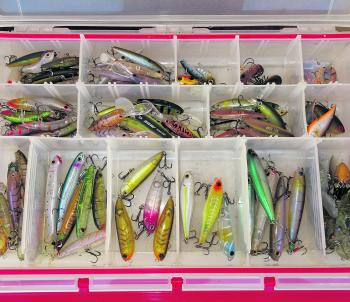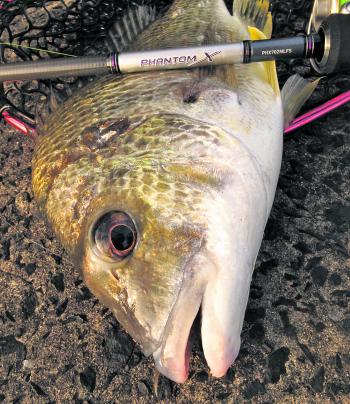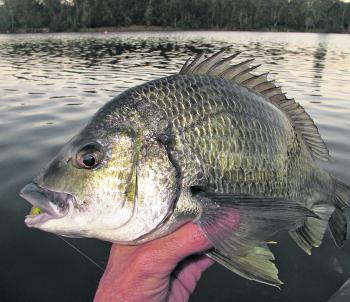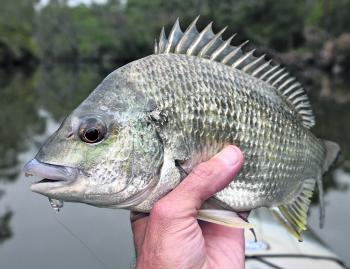Lure casting for bream sits right at the top of the Aussie-angling list. This branch of the sport has grown from humble and experimental beginnings four decades ago into a multimillion-dollar growing industry.
Consequently, the volume of bream lures available to us seems limitless, with newer and advanced types constantly hitting the market. They range from intricately crafted works of art through to bizarre oddities that you’d think would scare the fish away! Some come and go, while others go on to become classics that earn a reputation of excellence among serious bream anglers.
With such an enormous array of lures on the market, does it make sense to own as many as possible? Aside from verging on the impossible and draining the bank balance, it’s probably not practical to spend a lot of time and money buying up and then giving each lure a run to see how it goes.
That’s where feedback from different anglers helps determine which types do well and are worth a try. Angling publications, websites, forums, TV shows and DVDs all spread knowledge and it doesn’t take long before a hot performer becomes well known. Of course, some lures that are probably very good can easily fly under the radar and fade into obscurity, while others end up more popular due to hype and marketing over real world performance.
Perhaps the best approach to buying lures with the aim of using them on bream is to partly take in the gospel from fishing media and big name tournament anglers and do the rest purely by experimentation, seeing what works for you on your home turf. Even around my local waterways on the Central Coast, some lures will work fantastically in one spot and be almost useless at another spot. Time on the water, and trying different techniques is the only way to see what’s hot or not.
During the late 1980s this style of fishing was starting to become more popular largely due to smaller hardbody lures arriving on our shores. I still remember Steve and Tim Morgan enthusiastically casting the new translucent Rebel Crawfish around Brunswick Heads during that period, which is a classic example of the type of lure that heralded the bream angling boom.
Small hardbody lures, with a bib that makes them dive and swim with a wobbling action soon became the standard bream lure around the country. Most of the early favourites were American types, but a few local manufacturers came up with some excellent lures as well.
As the style of fishing advanced, it became quite obvious that bream also hit lures on the surface, particularly through the warmer months. While any of those diving hardbodies could effectively catch bream by leaving them sitting motionless on the surface, small bass style poppers and even flies tied to resemble insects proved more successful and so surface lure breaming was born.
Eventually a new type of lure changed everything. Soft plastics, often referred to as ‘squidgies’ by a couple of South Coast bream anglers, made an entrance into the market. The softy boom ended up taking anglers by storm, and within the space of a few years hardbody luring for bream had faded substantially. Perhaps the biggest hit among these newer softies was Berkley’s 3” Powerbait Minnow, in the incredibly effective pearl/watermelon colour.
Things keep evolving and despite the popularity of soft plastics, the earlier style hardbodies have had resurgence, this time with a distinctly Japanese flavour. Around 2007 anglers started to use little metal lures, commonly called blades or vibs. This form of lure ended up being one of the deadliest of all.
Now the bream luring world is filled with all forms of lure, soft, hard, deep, surface and everything in between. Each type has a time and place when it will probably outfish the rest of the pack. Overall it’s a good idea to have at least a few different styles, sizes and colours in the kit.
The fatter models are generally referred to as crankbaits or simply ‘cranks’ these days, whereas the narrower profile designs are sometimes called minnows or jerkbaits. Some of these are specifically designed to dive down and then suspend at that depth in the water column – they’re called ‘suspenders.’
Just like back in the early days, diving hardbodies can be used in a very wide range of places, at different times of year and they work equally well on southern black bream or warmer water yellowfin bream.
Some good examples of places to use such lures are among fallen timber in creeks, along oyster racks, around moored boats and pontoons as well as along rockwalls and bridge or jetty pylons. They don’t go so well in very strong currents or when trying to get down towards the bottom in deep water. A lot of experienced bream anglers prefer the fat or rounded body models, although I like the thin profile jerkbait or minnow types a lot more.
A softy can be adaptable, depending on the size or weight of the jighead that it’s matched with. So one plastic could be cast over shallow flats with an ultra-light HWS type of jighead or be worked down on the bottom in 5m of water when threaded onto an 8g jighead.
As a general rule, soft plastics need to be fished slowly and more precisely than most other styles of lure, so if you’re unsure of exactly where the bream are, it could be better to use a hardbody as a searching lure and then swap over to a softy if numbers of fish are located. Smaller, scented or heavily flavoured softies like Berkley Gulps are particularly good for hesitant bream in very clear or cold water.
It’s possible to catch both black and yellowfin bream on a surface lure during any month of the year, including the very depths of winter. However, these lures are at their best through the warmer months, when bream look for a meal in the form of prawns, shrimp or insects ranging from moths and cicadas, through to flying termites. Casting surface lures over shallow flats, adjacent to rocky points or similar shallow structure is normally the best approach, but sometimes they’ll entice bream over much deeper water.
There’s no real right or wrong way to use surface lures for bream and each day is different, so it can take some experimentation to see what’s working or not. Generally these lures are better cast earlier or late in the day, when light levels are low.
There are basically three types of vibe or ‘vib’ on the market and they all work very well. The smaller metal blades sink quickly and are normally the best choice for deep water or where the current has a bit of push to it. Middle or lightweight plastic versions are reasonably adaptable, but tend to work well in average depths, with minimal current flow, such as lakes or bays. A later variation of these is the soft vibe, which is similar with a soft plastic tail section.
An important aspect of vibes, particularly the metal blades are that they are probably the most likely form of lure to get snagged on the bottom or among bankside structure. Fitting them with single or upwards facing W hooks may improve this, but they still snag up more than floating hardbodies or soft plastics.
They’ll catch bream at any time of year, in a variety of places, but are particularly successful during winter and are possibly more popular in the southern states for black bream. From my experience though, warm water yellowfin bream really love them too!
Robley’s favourite bream lures
Daiwa Tournament Baby Vib 47s
Ecogear ZX30 or ZX35
Berkley Gulp 3 inch Minnows (pumpkinseed, camo or watermelon)
Berkley Gulp 2 inch worms (camo or motor oil)
Squidgy Wrigglers 80mm (wasabi)
Ecogear PX45 or PX55
Daiwa Silver Wolf Slippery Dog 65mm
Viking Lures Pop’n’Crank
Maria Jerkbait 50mm
Reads: 4066
With such an enormous variety of small lures on the market these days it’s not always easy to make the best choice. The simple tips outlined in this article should set a few things straight though.

The author picked up this solid Lake Macquarie fish just before sunrise. Choosing the right lure is a large part of success, but other factors such as just getting out of bed super early are equally important.

Bream are a widespread and adaptable species, so it makes sense that they’ll take interest in an array of different lure types. While most lures work, some are simply a lot better than others.

This fish snatched a small sinking vibe worked down deep in winter. As a rough guideline, try sinking lure types through the cooler months and shallower or surface types when things heat up again.

It’s always good when you hook a solid fish on the very first cast. This fish snaffled up a hardbody diving lure just after it landed.

Most coastal creeks house plenty of bream, but not all lures are ideal for this sort of environment. The author favours surface lures most of the time, as they attract the fish’s attention and are the least likely types to snag up on bank-side timber.

This fish smashed a surface lure right in the guts of winter. It goes against the trend, but we should always remember that regardless of how much we think we know, fish don’t read the rulebooks!




